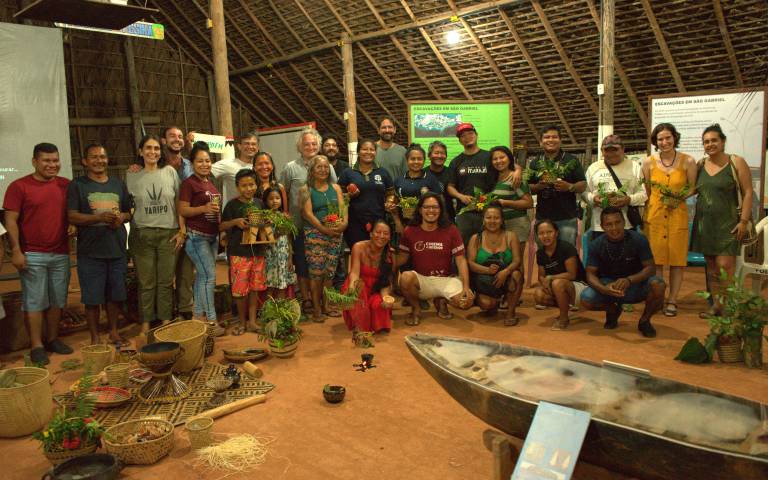UCL archaeologist Dr Manuel Arroyo-Kalin has been working with Brazilian researchers and indigenous peoples to help better understand and share their cultural heritage.

Along the banks of the Rio Negro in northwest Brazil, there lies the largest untouched rainforest tract in the whole of the Amazon basin, demarcated as an indigenous territory.
Archaeologists, anthropologists, and other scholars, as well as indigenous peoples themselves, know that the region was inhabited in pre-colonial times. Yet archaeological knowledge about the details remains scarce.
Since 2019, thanks to a British Academy/Global Challenges Research Fund grant in Sustainable Development, UCL archaeologist Dr Manuel Arroyo-Kalin has led an exciting interdisciplinary project there. It seeks to uncover evidence of age-old human occupations, as well as developing intercultural dialogue with local indigenous communities.
Partnering with researchers from Brazilian museums - Museu da Amazônia (Musa) and Museu Paraense Emílio Goeldi (MPEG) - as well as São Carlos Federal University (UFSCar) and NGO Instituto Socioambiental (ISA), the Intercultural Archaeology Programme of the Northwest Amazon (PARINÃ) took shape. It is a long-term research strategy that aims to study the history of the north-west Amazon through intercultural engagement with the people living there.
PARINÃ archaeologists helped to train the region's first indigenous archaeology students, involving them in archaeological excavations uncovering artefacts that could be up to 2,000 years old.
In February 2023 the team presented initial results of these excavations, alongside other project outputs, in an exhibition in São Gabriel da Cachoeira. This small municipality in the Brazilian state of Amazonas is widely known as "Brazil's most indigenous town", due to its location within a territory inhabited by more than 25 different indigenous groups, each with its own language. The exhibition, entitled Memories of Ancestral Landscapes and curated by Musa, aimed to return to the community the results of recent research, even if in its early stages, in an accessible and meaningful way, with a view to promoting discussion about the relevance of cultural heritage.
Dr Meliam Gaspar (MUSA) and student archaeologists excavate artefacts as part of the PARINÃ programme in the Amazon.
Left: An indigenous ceramic specialist from Taraquá shows Dr Manuel Arroyo-Kalin wares from the Amazonian rubber boom era. Right: A decorated pre-colonial adorno found at the time of excavation.
São Gabriel da Cachoeira, on the banks of the north-west Amazon, is considered Brazil's most Indigenous town
Dr Arroyo-Kalin is Associate Professor in Geoarchaeology at UCL Institute of Archaeology, where his research focuses on the Amazon. He has spent 24 years working in Brazil, Peru, Ecuador and Colombia, including nearly a year spent living with local communities on the upper Rio Negro.
His expertise is in soils and geoarchaeology, having studied the phenomenon of the Amazon's anthropogenic 'dark' earths: patches of rich soils formed where pre-colonial settlements were located, in time becoming expanses of fertile ground.
Dr Arroyo-Kalin explained: "The site is dominated by black soil - or dark earth. In the context of the broader cultural history of Amazonia, you begin to see the formation of these when people became more fixed and adopted sedentary life. The north-west Amazon has always been seen as a nutrient-poor region, implying past populations would have been small and hence no dark earth would have formed; we are finding evidence of the opposite."
Pre-colonial indigenous people in the Amazon basin would change the nature of soils by discarding, burning, and/or composting charcoal, ash, bone, vegetable refuse and pottery shards around their communities. Over generations, the ground was transformed into a rich, fertile soil that could sustain crop cultivation.
Peeling back layer after layer
By studying ancient objects uncovered with the archaeology students during excavations in 2019 and 2022, plus drawings, photographs, testimonials, and documents relating to people who lived in the area during several periods, the team gained a detailed picture of daily life hundreds and even thousands of years ago.
The team painstakingly peeled back layer after layer of soil to reveal the remains hidden beneath - pottery, charred plant remains, stone artefacts, and the dark earth itself.
Dr Arroyo-Kalin said: "We work with local descendent communities showcasing what lies beneath their feet. It is unique because we are working with the first generation of indigenous archaeologists that have been trained in this region.
"Our second excavation was at the plaza associated with the main church that the Catholic missionaries built in the early 20th century in São Gabriel da Cachoeira. Inhabitants of the city became very interested in finding out more about a place that they'd walked past their entire life. Records from the 16th century refer to the northern half of the Amazon basin as where El Dorado was located, and we had lots of people stop and joke 'Are you looking for gold?'"
PARINÃ was recently featured in a US TV film "Ancient Builders of the Amazon," directed by Graham Townsley. One of the students who took part, Ana Keila Fontes Da Silva, said: "I want to get involved with archaeology. And I do it so I can learn the story of my people. These days, my people are interested in reclaiming the history of our indigenous Tariana community, learning how we got from the past to where we are now and into the future."
The exhibition was hosted at the Knowledge Longhouse of the local indigenous political federation, FOIRN - which held a special significance.






